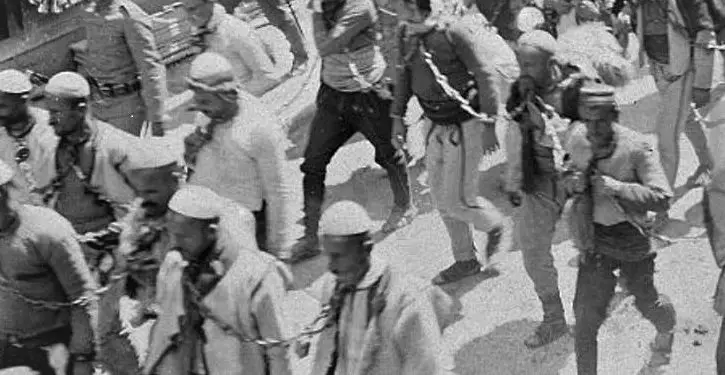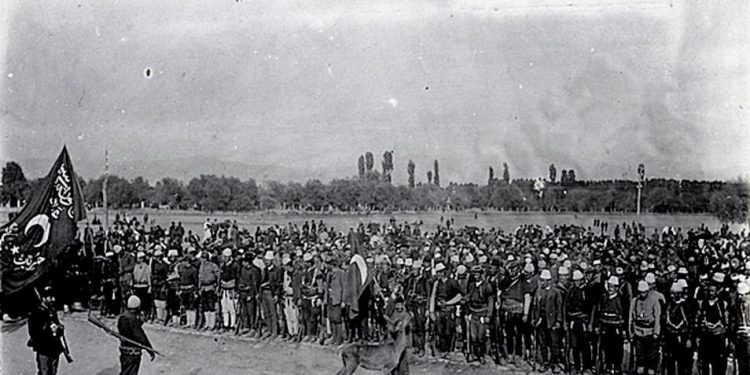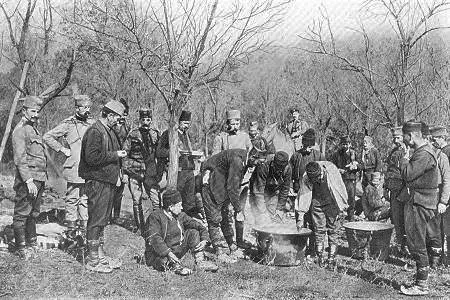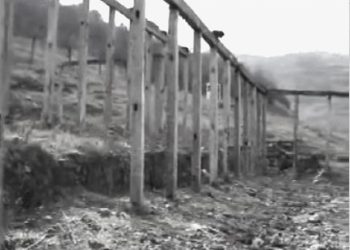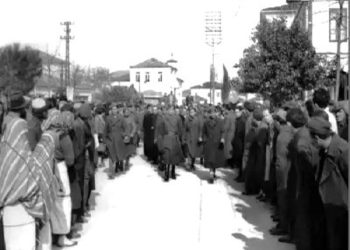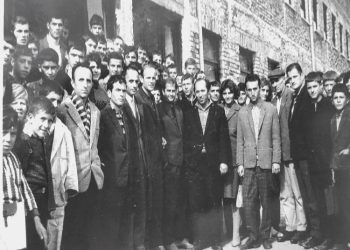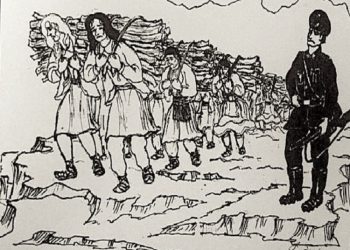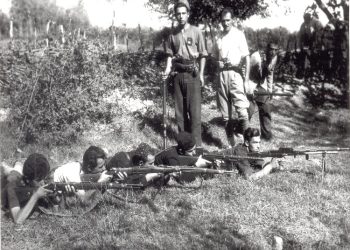From Bashkim Trenova
Part eight
ALBANIANS ACCORDING TO THE SERBS
(THE EASTERN CRISIS AND THE BALKAN WARS)
Memorie.al/ “Serbs are descended from the Slavs, a large number of tribes that gave birth to the Slavic peoples. Knowledge about the origins of the history of the Slavs is modest and not so clear. Their name appears for the first time in the 6th century AD, when Byzantine writers start talking about the Slavs….”! (Dushan Bataković, Milan St. Protic, Nikola Samardžić, Aleksandër Fotic. History of the Serbian People. L’Age d’Homme. Lausanne. 2005. Pg. 3.)
Continues from last issue
INSTEAD OF THE PROLOGUE – A PROJECT, TWO MEMORANDA AND AN ANALYSIS
The Project or Nacertania of Ilia Garasanin – politician, prime minister of Serbia during the years 1852-1853 and 1861-1886:
MYTH-MYSTICISM, VICTIMOMANIA, RACISM AND SERBONOSTALGIA
America and the European Union in its war against the most democratic, civilized and conscientious Balkan people – the Serbian people. What a democratic mission of world progress hegemony, what a victory for American ideology! This alliance with Albania and the barbaric and predatory gangs of Hashim Thaçi in the war against Serbia, then Russia, then Europe, especially Germany, represents a moral misery, a true disaster of American democratic civilization, but also a triumph of American imperialism – the conquest of Kosovo and the domination of the Balkans as a starting point for an invasion of the Caucasus, of Russia, of “bloody” oil.
As in the Middle Ages with the Turkish penetration into Europe, now with the Americans, the modern Ottomans, the Balkans become a springboard for the conquest of Europe, to put Europe in complete dependence on America, the new lord of the world. (1)
—
One million Serbian books were burned in the municipal libraries of Kosovo and Metohija. No one writes or talks about it. But when houses, churches and monasteries burn, what does the burning of books represent? Arnaut cynicism. No, Islamic and religious pogrom of everything Christian and Serbian.
****
Djordje Borozan – academic, dean of humanistic studies, specialized in the history of diplomacy and academic writings:
In recent years, we have witnessed the spread in the most influential national historiographies in the world, of the literature dealing with the “Kosovo issue”, which, not dealing critically with existing historiographical ideas and resorting to analogies, stereotypes and generalizing statements, obscures the truth, adapts to political propositions and shows its obsessive attraction to this subject, blurring the line between facts and their interpretation.
1-Dobrica Qosic. Le Temps des serpents-Notes de l’écrivain 1999-2000. (Time of Serpents-Writer’s Notes). Pg. 211. See also – Discours de haine en Serbie. (Hate speech in Serbia). Comité d’Helsinki. Pescanik. 20. 04. 2010.
2 – Ibid. Pg. 213-214.
Albanians have actually taken oppressive measures in the service of the Turkish regime and entered the 20th century filled with a deep religious and political hatred. Their permanent terror, blackmail and crimes against the Serbian population of the Kosovo vilayet, were exercised especially between the years 1878 and 1912.
During the Eastern Crisis of 1875-1878, the Albanian anti-Serbian movement was born, used to defend the territories of Turkey lost in the wars with Serbia and Montenegro. From the beginning of the kingdom of the Serbs, Croats and Slovenes, the Albanians, dissatisfied with the end of the war, took advantage of the Paris Peace Conference in 1919-1920 and, through rebellions and resistance, sought to attract the attention of diplomats and politicians gathered in Versailles, with the aim of Kosovo and Metohia joining Albania.
For this, the kachak movement was organized. It aimed to carry out permanent terrorist activities against the civil and military authorities and to make impossible the implementation of the laws and regulations of a state which, in this field, faced a long series of risks due to the uncertainty related to the situations in Albania and the final determination of its borders…!
Thanks to the gradual disappearance of the Serbian, Montenegrin and other non-Albanian populations from the regions of Kosovo and Metohija throughout the war, the preconditions for establishing a “new border of Albania” were created. The murders, arrests, persecutions and other forms of oppression against the Serbian and Montenegrin population, accompanied in parallel with an uncontrolled immigration of Albanians from Albania, changed the demographic map of the area, which is attached to the protectorate of “Greater Albania”.
The Albanianization of Kosovo and Metohija – a long process – has continuously disturbed the ethnic homogeneity of the Serbian and Montenegrin population throughout the present century, has damaged the understanding of the goals of the Yugoslav state, has hindered the implementation of constitutional and legal norms, has encouraged the migration of the population non-Albanians through the systematic encroachment of their individual property and their political security, persistently strengthened the separatist movement and has repeatedly demanded the redefinition of the Yugoslav federation. (1)
****
Djordje Jankovic – archaeologist, doctor of sciences and professor at the Faculty of Philosophy at the University of Belgrade:
For the sake of truth, I must emphasize that among Serbian intellectuals the opinion has spread that the legend of Kosovo, the legends of Saint Prince Lazar and Milosh Obiliç, and even Saint Sava, are products of the Serbian elite of the 19th century, especially of the church and that this elite intended to create the conditions for the awakening and liberation of the nation as a prerequisite for the unification of the nation and the country.
Some of the most important archaeological excavations carried out in Albania are quite complementary. They show that the ancestors of the Albanians settled between the Drin and the Adriatic coast in the middle Ages.
Let us discuss, quite briefly, taking into account the available space, the archaeological data that prove the possible origin of the Scyptians, namely the Albanians. From the beginning, it can be said that there is no essential connection between the population of Kosovo and Metohija in the 5th centuries.
1 – Djordje Borozan. Réponse au livre de Noel Malcolm Kosovo-Une brève histoire. Scientific discussion on Noel Malcolm’s book “Kosovo. A Short History”. (Response to Noel Malcolm’s book “Kosovo-A short history”). (Macmillan, London 1998, 492). 8.10. 1999. Institut d’Histoire de l’Académie Serbe des Sciences et des Arts. Collection d’œuvres.Volume 18. Belgrade 2000 and VII and the Albanians. Continuing his discussion of the origin of the people he calls Albanians, Malcolm notes that in the past they never described themselves using this name, but, as an exception, in 15th century Italy they are described as arboretum (p. 29).
In passing, in a note, he mentions the hypothesis regarding Albania in the Balkans and Albania in the Caucasus, but rejects it, because he finds no connection between the two areas. This claim is unfounded, since both Albanians were close to the borders of the same state, Byzantium. Albania located in today’s Azerbaijan, mentioned by this name by Ptolemy, was known in the middle and late middle Ages with the names “Albania”, “Agwank”, “Aluank”, “and Arran”. A map from 1482 shows a migration of different tribes. It is very likely that the Arberians then went to Byzantium, which enabled them to settle in the areas north of the Thessaloniki-Durres road, strengthening Byzantium’s border with Serbia.
It is only a matter of time when individual archaeological finds from Albania will be linked to these recent arrivals from Asia. It is clear that the ancestors of the Albanians, a nation formed in our time, are various tribes of Asian origin, who, arriving between the 7th and 11th centuries in the mountainous regions of today’s Albania, mixed with the Slavs, who lived in this undulating space and with the Latin-speaking and partly Greek-speaking population, who lived in the coastal cities.
Therefore, the philological claim that today’s Albanians are of autochthonous origin is unfounded. It is clear that among dozens of archeological objects and hundreds of objects in the region of Kosovo and Metohija, dating from the time before the Nemanjičs, identified and positively expressing Serbian or generally Slavic characteristics, there is not a single find that can belonged to the ancestors of the Albanians of the middle Ages. (1)
1 – Djordje Jankovic. Réponse au livre de Noel Malcolm Kosovo-Une brève histoire. Scientific discussion on Noel Malcolm’s book “Kosovo. A Short History”. (Macmillan, London 1998, 492). 8.10. 1999. Institut d’Histoire de l’Académie serbe des sciences et des arts. Collection d’œuvres. Volume 18. Belgrade 2000.
****
Dorde M. Srbulovic – historian:
Serbs live with myths…! The same thing has happened here: it is not just about a simple revenge: Kumanova for Kosovo, it is also this, but not only that. This is the Holy Land, which has been profaned and is being sanctified, turning to worship, becoming again an earthly mirror of Heavenly Serbia…why did the war break out?
For tens of years, the Turks, aided by the Arbans and Bashibuzkas, carried out terrible violence against the Christian population of Old and Southern Serbia. In the European part of Turkey there were about 6 million inhabitants, including 3.5 million Christians: mainly Serbs, then Greeks and Bulgarians. Europe remained indifferent to their suffering. The objections, complaints, prayers and entreaties of the Balkan states for the European states to influence to improve the basic living conditions of the Christian and Orthodox population did not bear fruit. On the contrary, under the guise of a “peaceful solution” to the problem, the Turks received an undisguised message to continue the violence…!
Never in the history of our people has there been such a union: crown, church, army, peoples, political parties, illiterates and scholars, all united, and never has there been so much enthusiasm for war. It was not a problem how to mobilize the people, but how to explain to the non-mobilized that they should not go to war, because there was not enough equipment and weapons for everyone. So they followed the army on foot as civilians. It was the greatest shame for them to return home, to their villages and towns, where they would be laughed at, because there were only women, children and old people left. (1)
1 – Dorde M.Srbulovic: Srbi i Srbija sto godina posle Kumanovo. (Les serbes et la Serbie cent ans après Kumanova – Serbs and Serbia a hundred years after Kumanova.) Nemanja. 28. 10. 2012. Page 1.
****
Dushan T. Bataković – professor of history at the University of Belgrade, ambassador:
Kosovo, with the neighboring regions, was the center of Serbian Orthodoxy and the most solid key point. The Serbs are descended from the Slavs, a large number of tribes, who gave birth to the Slavic peoples. Knowledge about the origins of the history of the Slavs is modest and not so clear. Their name appears for the first time in the 6th century AD, when Byzantine writers start talking about the Slavs and their allies, the Ants. (1)
—
During the Great Migration of 1690, the Serbian people suffered a powerful blow in the regions under the Ottomans. In fact, it is the ablest and bravest elements of the population who abandoned during this era the old Serbian lands to settle in the lands on the other side of the Sava and the Danube. (2)
—-
During the period since the Eastern Crisis of 1876, Old Serbia fell prey to a great deal of tribal anarchy. All this space was given, outside the law, to the Albanian bejlers, who levied new taxes on the Christians, while numerous gangs, completely free, plundered the Christian villages. The Serbs had difficulty organizing themselves because the Orthodox bishops of the region were Greek, while the Albanians, whose numbers continued to grow as a result of the influx of mountain tribes into the villages of Metohija and Kosovo, exerted an increasingly strong oppression. Many Serbs, faced with extremely heavy taxes, waves of violence and lack of help from Belgrade, left to take refuge in the free principality of Serbia.
1 – Dushan Bataković, Milan St. Protic, Nikola Samardžić, Aleksandër Fotic. Histoire du peuple serbe. (History of the Serbian people). L’Age d’Homme. Lausanne. 2005. Pg. 3.
2 – Right there. Pg. 165.
The reversal in the statistical ratio between Serbs and Albanians, as a result of continuous migratory movements, was visible in the cities. A new demographic upheaval occurred during the Eastern Crisis, when 30,000 Albanians would leave Southern Serbia to settle in Kosovo and Metohija, while at least an equal number of Serbs moved to Serbia. (1)
—
After the Albanian League, founded in 1878 in Prizren, a large number of Serbs would die during the campaigns undertaken by the Albanian gangs. The sufferings of the Serbs would continue throughout the reign of Sultan Abdylhamid II (1876-1909), who relied on pan-Islamism and supported the Muslim Albanians at the expense of the Christian Serbs.
In addition to the help of the Sultan, the Albanians could count in their favor against the Serbs the support of Vienna, which sought to use the Albanian movement as a trench to penetrate deeper into the Balkans. By 1900, according to Serbian statistics, about 60,000 Serbs were forced to go as refugees to Serbia, and this trend would continue even after the intervention of the great powers between 1903 and 1908.
The martyrdom of the Serbs in Kosovo, as a result of the new uprisings of the Albanians, will continue until 1912, when the Serbian and Montenegrin soldiers were received as liberators. In total, during the period 1830-1912, the number of Serbs living in Kosovo was halved, while that of Albanians doubled. (2)
At the Founding Congress of the Communist Party of Serbia in 1945, the main task of Serbian communists was to lead the “war against Serbian hegemony”.
1 – Dushan Bataković, Milan St.Protic, Nikola Samardžić, Aleksandër Fotic. Histoire du peuple serbe. (History of the Serbian people). L’Age d’Homme. 2005. Lausanne. Page 210.
2 – Ibid. Pg. 211.
The organization of the borders of Serbia was done in the region of Raša (Sanjak), with minor changes, according to the model of 1878, which was equivalent to canceling the achievements of all previous liberation wars. By separating Macedonia, a large part of the results of the Balkan wars was destroyed. (1)
The period that follows the great migration of 1690 marks the beginning of the real Albanian colonization of the vacated regions of Kosovo and Metohija. The internal disturbances in the Ottoman Empire and the departure of a part of the Serbs towards the north, favored the colonization of the region by large tribes of Albanian herders, who would occupy the old mining sites in the Kosovo plain and become owners of large possessions. (2)
—
The end of the 17th century, characterized by an increase in religious intolerance in the Ottoman Empire, marks the beginning of the partial Islamization of the Kosovo Serbs. This has been accepted either as an inevitable evil or for profitable reasons. The first generations of Islamized Serbs will preserve their language and honor ancient customs (Slava, family saint’s feast and Easter holidays), in secret.
After a few generations, surrounded by Albanian settlers, the Serbs will wear Albanian costumes, will settle outside a close family circle, and will speak Albanian. A special form of adaptation would thus be created, where in order to survive, all the external characteristics of the dominant group were acquired.
Simply put, the Albanianization of the Islamized Serbs started with their marriages to women from Albanian families, as a result of which integration took place in their tribal community. For a long time, Orthodox Serbs have called their Albanianized brothers Arnautashi, who have lost their memory of their origin. Until the end of the 19th century, Arnautashians preserved their family names, especially in Metohi, in the region of Peja…(1)
1 – Dushan Bataković, Milan St.Protic, Nikola Samardžić, Aleksandër Fotic. Histoire du peuple serbe. (History of the Serbian people). L’Age d’Homme. Lausanne. 2005. Pg. 344.
2 – Dushan Batakovic. Kosovo: La spirale de la haine, les faits, les acteurs, l’histoire. (Kosovo: the spiral of hatred – facts, actors, history). L’Age d’Homme. Lausanne. 1993. Pg. 23.
—
At the beginning of 1878, the vanguard of the Serbian army quickly entered the field. From the liberated regions of South Serbia, about 30,000 Albanians left to settle in Kosovo. So the reprisals followed; the new arrivals began to take revenge on the Serbs of the province for losing their possessions in Serbia. Several tens of thousands of the latter would immigrate, as a result, to the liberated territories under Serbian control.
The “Bloody Sultan” saw in the Christian movements of the Balkans and Asia Minor the source of all the evils of the empire. The iron fist of his blows in Europe was the Albanians…! As guardians of the Empire against Christian uprisings, the Albanians enjoyed obvious privileges; they did not pay taxes, did not perform military service and did not obey the local Turkish authorities. (2)
—
Albania – Serbia’s “Achilles’ heel”, as Serbian Prime Minister Nikola Pašić called it, often violated the Serbian borders, trying to organize uprisings in Kosovo and Macedonia. Serbian army units had to intervene in many cases against the insurgents, which the Viennese press, tried to present to the European public as a massacre of innocent civilians. (1)
1 – Dushan Batakovic. Kosovo: La spirale de la haine, les faits, les acteurs, l’histoire. (Kosovo: the spiral of hatred – facts, actors, history). L’Age d’Homme. Lausanne. 1993. Pg. 24.
2 – Right there. Pg. 26-27.
Kosovo’s problem appears, first of all, as a problem of delayed and unfinished modernization in a dominantly agricultural and semi-urban environment, locked in its patriarchal and tribal and necessarily nationalist traditions. (2)
—
The Treaty of Sistova (1791) provided for the amnesty of the Serbs, but the Muslim Albanians, either as insurgents or as soldiers in the armed units of the Pashalars in Kosovo, continued to plunder the Christian population. The local authorities did not have the means to stop them. The wave of religious intolerance, which, after hostilities between the Russian and Ottoman empires, also affected Serbia, led to de-Christianization and Islamization. The suppression of the Patriarchate of Peja (1766), whose rich land holdings had long been coveted by Albanian beylers, prompted a final wave of Islamization among the Serbs of Kosovo and Metohija. (3)
Before a serious crisis, the John-Turkish regime announced the organization of new elections. Belgrade expected the Young Turks to win the elections and sent instructions to the Kosovo Serbs to support the Ottoman government…. The Albanians, fierce opponents of the John-Turk regime, encouraged by their bosses, renewed their attacks against the Serbs. (4) Memorie.al
The next issue follows




